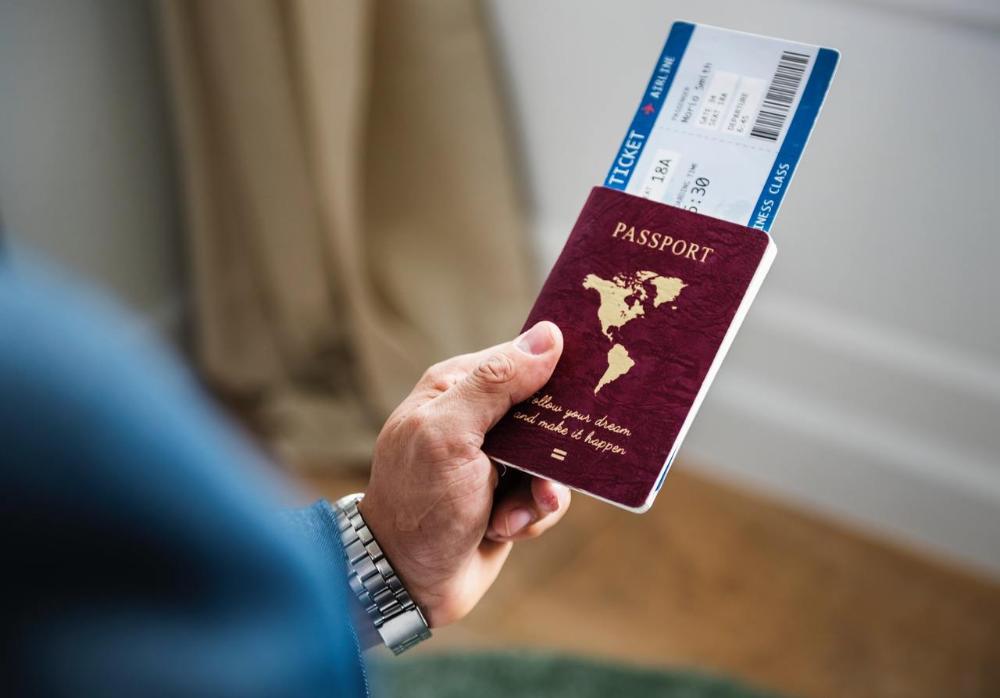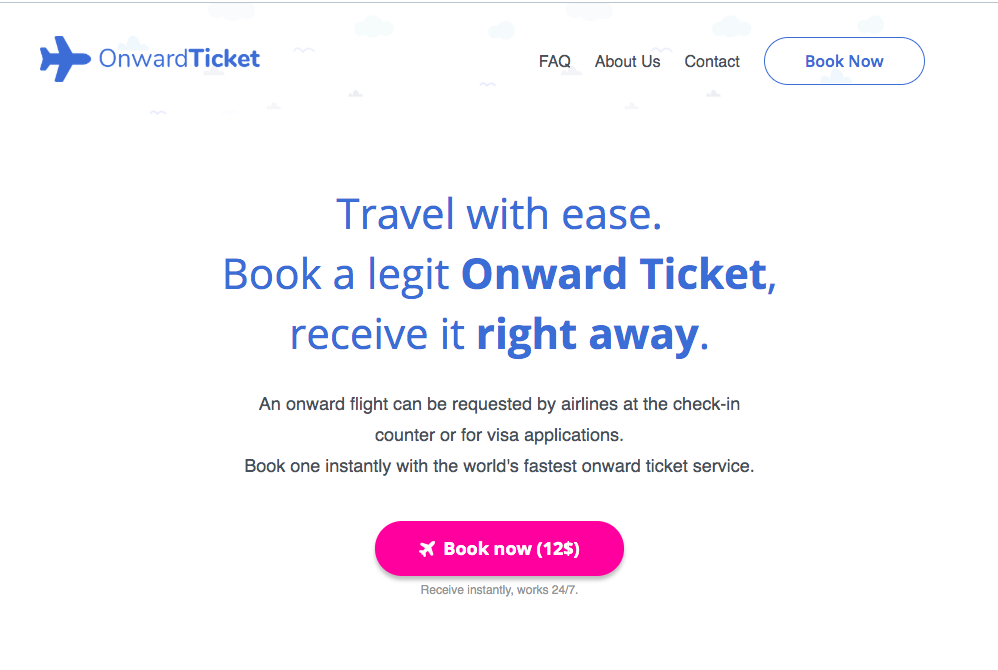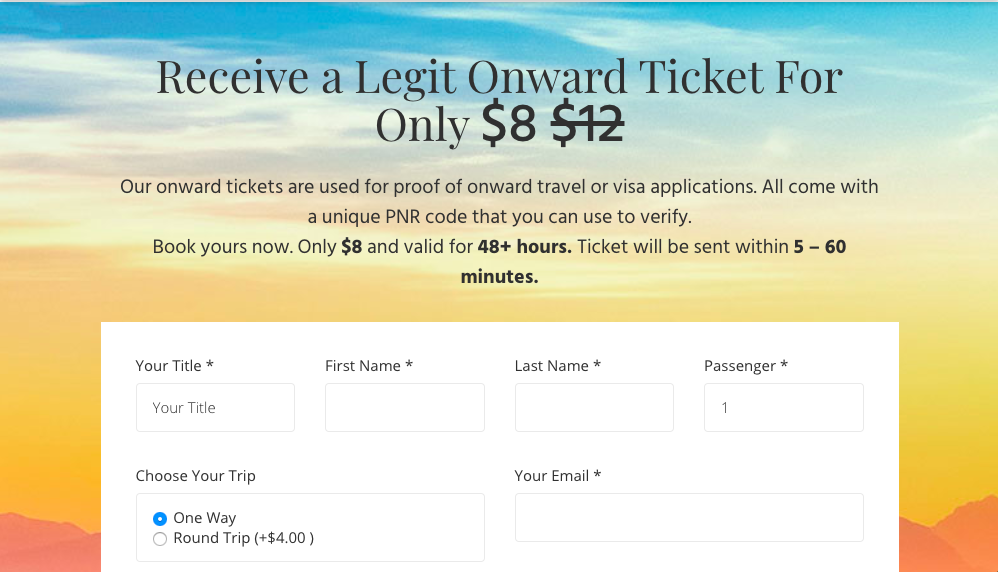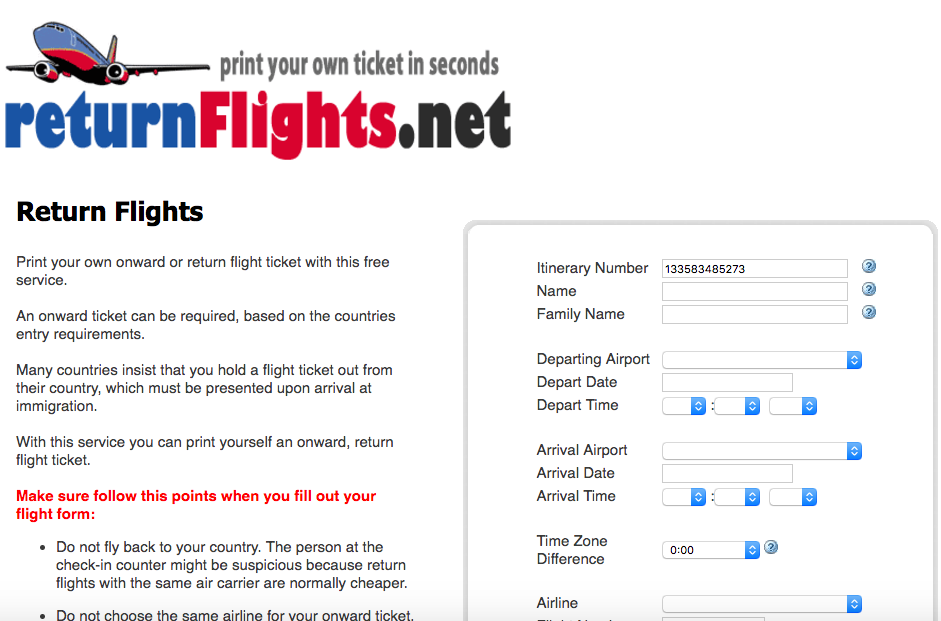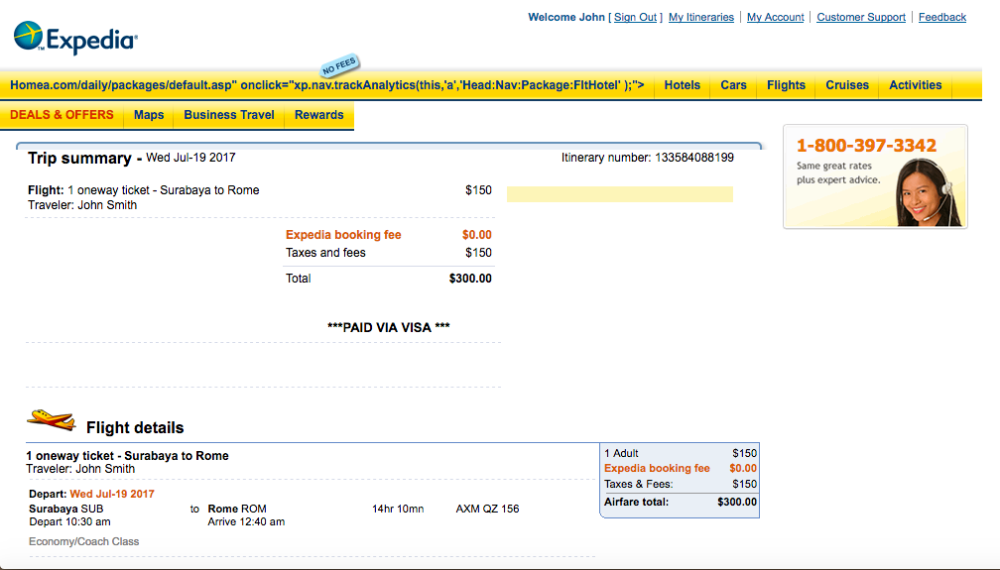The 7 Best Ways To Provide Proof Of Onward Travel At Airports & Immigration
“Where is your ticket out of Indonesia?” the solemn faced immigration official questioned us, as we stood side-by-side at the immigration desk in Medan’s Kualanamu International Airport in Sumatra, Indonesia.
“It’s here” we replied, handing over the printed ticket confirmation e-mail, detailing the booking of an Air Asia flight that was scheduled to leave Indonesia in a few weeks time.
The man scrutinized the sheet of paper for what seemed like an eternity, before finally handing it back to us, taking our fingerprints and telling us that we were free to enter the country.
Another travelling couple that had taken the same flight as us did not make it through immigration quite so smoothly. They had apparently not been aware of the requirement or had taken the risk of not coming prepared with proof of onward travel.
As we sailed through immigration, this unfortunate pair was taken aside for questioning and God only knows if they eventually succeeded in entering the country.
What is the proof of onward travel requirement?
The “proof of onward travel” requirement causes a great deal of inconvenience and frustration to many travellers that are visiting foreign countries, whether they're arriving by air, sea or land.
The requirement can also cost travellers a lot of money if they don’t know how best to deal with it.
The proof of onward travel requirement is stipulated by the Department of Immigration in many countries and states that a traveller must possess documentation proving that he has already planned ahead and made concrete travel arrangements for exiting the country.
In practice, the requirement is not always enforced, but when it is, the authorities usually demand evidence that the traveller has booked a flight out of the country by asking to see the flight confirmation e-mail sent by the airline in question. This is sometimes referred to as “the ticket out”.
The onward flight doesn’t necessarily have to be a return flight to the traveller’s home country or originating destination.
If the traveller only has a one-way ticket, he will be asked to provide evidence that he has booked an onward flight to another country that he is permitted to visit.
There is also a very minute chance that you will be asked to provide proof of onward travel from that next country too, and so on and so forth, all the way up until the final flight back to your home country, but we have never experienced it in three years of travel.
Usually, the authorities just want to see that you have booked yourself onto a flight out of their own country.
Sometimes the onward travel requirement will be waived if the traveller can demonstrate evidence of sufficient solvency to support himself during the course of his stay, but this is certainly not always the case. A healthy bank balance or a big wad of cash in your wallet is not always enough.
Where is the requirement enforced?
In reality the responsibility for checking travellers is often passed on to the airlines and hence travellers will often be asked to provide documentation at the airline check-in desk.
In fact, if you’re flying to the Phillipines, you will almost certainly be asked for proof of onward travel at the airport check-in desk, as the Phillipines is one of the strictest countries in this regard. If you can’t provide proof you will be denied boarding in most cases.
The airlines only ask for it because they will have to pay for your deportation or may face heavy fines if you are rejected at immigration for not having proof of onward travel.
Indeed, officials at immigration do not solely rely on the airlines to check every traveller and they will occasionally ask to see your ticket out as well.
While some airlines will let you sign a waiver at the check-in desk to ensure that they cannot be responsible if you’re caught at immigration without a ticket out, this is not the case for all airlines.
We’ve heard that countries in Central America such as Panama and Costa Rica can be particularly strict on this requirement too. Many travellers get caught out when crossing overland into Panama. The US carrier Delta Airlines also has a reputation for asking for proof of onward travel.
In practice, virtually any airline employee or immigration official could ask for it, when entering just about any country. There’s always a possibility you could be asked.
Why does the requirement exist?
The Government has presumably put the requirement in place in an attempt to curb illegal immigration.
The thinking seems to be that if a traveller has already booked a flight out of the country, he will be less tempted to overstay his visa and become an illegal immigrant, as he would then be at a loss by not utilizing his pre-booked flight.
A pre-booked flight also guarantees that travellers that run out of funds during their stay in the country will still be able to leave under their own steam, without having to be bailed out and thus costing the authorities money.
The problem it creates for travellers
One issue that arises from this requirement is that it doesn’t allow for spontaneous travel, where things are played by ear and decisions are made on the spur of the moment, when the time is ripe.
With this requirement in effect, travellers are forced to plan far ahead and make an untimely decision about not only what their next destination will be, but also when they will go there.
What if you want to reschedule that onward flight in the meantime, want to fly to another country instead or have to cancel the flight for unforeseen reasons?
If your ticket is non-refundable, as most plane tickets are, you will be at a loss if you don’t take the flight. Any spontaneous change of travel plans now comes at a cost.
Another part of the problem is that bus tickets, train tickets or boat tickets are not always accepted as evidence of onward travel.
Those wanting to travel overland or by boat to their next country will often have to book a flight that they will never use to meet the entry requirement.
That’s pretty ridiculous.
The requirement obviously serves the interests of the Government, while killing spontaneity for many travellers and potentially costing them a lot of money on wasted flight tickets that they’ll never use.
The solution
In this article we’re going to take a look at seven ways to deal with the proof of onward travel requirement, so that you guys can continue to travel spontaneously without incurring the high costs of booking a flight that you will never use.
Now if you’re the type of traveller that loves to fly everywhere and prefers to book everything way ahead of time, you probably don’t need to read this article. You will always be booking an onward flight ahead of time anyway so the requirement will not affect you negatively.
But if you’re the type of traveller that likes to travel spontaneously, make decisions on a whim or you prefer overlanding or sea travel as opposed to air travel, then this article is for you.
#1 - Wing it
One way you can approach the proof of onward travel rule is to take advantage of the fact that it’s often not enforced.
This is the laziest approach, where you just take your chances and arrive at the departure airport or border checkpoint without any proof of onward travel.
One advantage of this method over some of the others is that it ensures that you never waste money buying a plane ticket that you were never asked to show.
After all, agents at airport check-in desks don’t always ask for proof of onward travel and when you reach the immigration counters, there’s often a good chance you’ll sail past those too without being questioned by the immigration officer.
However, things will not always go so smoothly. We have been asked to produce proof of onward travel on a number of occasions, both at airport check-in desks and at various immigration checkpoints.
We recently got asked for proof at the check-in desk in Noi Bai International airport in Hanoi, Vietnam, when flying to Malaysia.
Also, as we mentioned in our story at the beginning, a very solemn looking immigration officer demanded to see our ticket out the very first time we arrived at Kualanamu International Airport in Medan, Sumatra.
Whether you get asked for proof depends on a number of different factors including the particular country you’re visiting and the strictness of its immigration policies, the airline employee or immigration official you’re dealing with, your nationality, your skin colour, your appearance, your demeanour on the day and lots of other variables.
You can maximize your chances of not getting asked for proof of onward travel by dressing smartly at the airport and not looking like a vagrant.
Looking well-groomed and keeping your hair cut reasonably short or at least tied back is also an advantage, as is travelling with a carry-on daypack as opposed to a large internal frame hiking backpack, which could mark you out as a stereotypical cash-strapped backpacker.
Emanating an air of confidence and self-assuredness in front of the airline employee or immigration official could also go a long way towards dispelling any doubts about your financial solvency or intentions to leave the country before your visa expires.
In any case, no matter what you do, you will eventually be asked to show proof of onward travel, even if you get away with it the first few trips.
Therefore if you are going to use this approach, you should be prepared to buy a ticket on the spot, just in case you can’t persuade the check-in agent or the immigration officer to let you through.
That means that you should arrive at the departure airport as early as possible, as you’ll need to leave time for booking a ticket online if the check-in clerk demands it. More time also means more time to search for a good flight deal so that you don’t get totally ripped off.
We read the very entertaining account of Lauren from Never Ending Footsteps who almost missed her flight because she only had 30 minutes to buy a ticket before the gate closed.
It might also be a good idea to have a data plan on your phone, as you may not always be able to find good free WiFi at the airport.
Most airport WiFi networks are password-protected or behind a paywall and the ones that are free often come with time limits or sometimes just don't work well enough to let you book a plane ticket in any reasonable length of time.
If you only have a laptop but no mobile device, a 4G USB dongle would be useful. You just insert a SIM card into one of these and get an Internet connection through the cellular network.
This devil-may-care approach could also cause complications if you’re trying to catch connecting transport from the arrival airport or border crossing. Getting held up at immigration because you don’t have a ticket out could definitely cost you time and cause you to miss your connecting train or bus.
It would be wise therefore to try to plan your journey so as to arrive at your destination airport or at the border checkpoint as early in the morning as possible, so that if you do get held up for not having a ticket out, you don’t risk getting stranded without onward travel options or having to pay for an expensive taxi to your final destination.
Is this the best method? We don’t think so. We like to be well prepared beforehand whenever we cross national boundaries, so that we don’t have to deal with any hiccups that might arise.
Travelling in this way frees the mind of any worries from anticipating what might happen and allows you to travel with more peace of mind.
Let’s look at a few other methods.
#2 - Buy the cheapest possible onward flight and eat the cost
It’s certainly a horrible and wasteful thing to have to buy a plane ticket that you’ll never use, but this is probably how a lot of overlanding travellers are dealing with the proof of onward travel requirement.
We would personally try to avoid this method, but it may be an acceptable solution for travellers that have ample funds and are willing to spend money to ensure that they avoid any hiccups at the airport check-in desk or immigration counter.
The idea is that you just buy the cheapest possible onward flight that you can find. Since you won’t actually be taking this flight, it can be going to anywhere and leaving on virtually any date before your visa expires. You can also choose an airline that you’d normally never dream of travelling with.
An easy way to do this in practice is to head over to Skyscanner and search for onward flights from your destination country to “everywhere”. Compare the prices across all the viable dates and book the cheapest one available.
Also, if you’re flying in from a nearby country, it might also be worth checking the prices of return flights. The cheapest option for providing proof of onward travel in this case, rather than booking an onward flight, might be to book a return flight and simply not use the return leg.
We’ve also written an in-depth article on how to always book the cheapest possible flight with tons of additional tips for booking cheap flights.
P.S – If you’re travelling in Southeast Asia and you’re going to use this method when entering Malaysia or Indonesia, last time we checked, there were flights going from Medan to Penang and vice versa for just £12.
#3 - Purchase a fully refundable ticket
Many American airlines like JetBlue, United, American, Delta and Southwest offer their customers the option to buy fully refundable plane tickets instead of non-refundable ones. Some Australian airlines also offer them, as do a few other select airlines around the world.
Buying a fully refundable plane ticket sounds like a great solution to the proof of onward travel requirement, at least in theory.
You buy the refundable ticket, print off the ticket or confirmation e-mail and use that as proof of onward travel. Then you cancel the ticket once you’re safely past immigration and you get your refund without any problems.
In practice however, there are some complications.
First of all, fully refundable plane tickets tend to be a lot more expensive than non-refundable ones. We’re talking 2-4 times more expensive in most cases.
While you can sometimes find fully refundable tickets for a few hundred bucks, you'll normally be paying more than $1,000. You almost certainly won’t be able to buy one from a discount airline.
These expensive refundable tickets only sell because people are afraid that they might have to cancel or re-schedule their flight for whatever reason. Airlines normally make a killing from cancellations and re-scheduling fees.
However when people buy a fully refundable plane ticket and don’t cancel their flight, they also lose money. Airlines turn a huge profit from these overpriced tickets, because most people don’t cancel and get refunded. Purchasing these tickets really makes no sense unless the flyer tends to cancel or re-schedule flights like nobody’s business.
But getting back to the main point.
Because refundable tickets are so expensive, you’re likely going to need either a fairly healthy bank balance or a good credit rating to buy one.
Whatever the method of payment, you’ll need to able to temporarily absorb a substantial financial blow.
Another thing to watch out for with refundable tickets is hidden terms and conditions or fees attached to the refund.
It might be that the refund only applies if the flight is cancelled within a certain number of days after purchase or that a fee is applied to the refund, which effectively means the ticket is not fully refundable. Some airlines will only refund you in vouchers and not real cash. Always do your due research before thinking you can count on one of these tickets.
If you’ve done your research and you are entitled to a full cash refund, getting that refund still may always not be so straightforward. Airlines don’t like issuing them and are often hesitant to do so, even if the ticket was supposed to be fully refundable.
Depending on the airline in question, the refund may be issued speedily within just a few hours or it could take days, weeks or even months.
Refunds frequently can’t be requested online either; you may need to make a phone call (and endure never-ending hold times) to the airline or visit the head office in person to get your refund processed. If this is the case, the whole idea could be more hassle than it’s worth.
So with those caveats in mind, how do you buy a fully refundable ticket?
Well, it can be somewhat difficult to find them actually. They aren’t always available when booking directly through the airline website. Some airlines may only offer them through a travel agent or when you book directly in person at one of their offices.
We suggest visiting a travel agent as they’ll have the requisite expertise and detailed knowledge of which airlines offer fully refundable flights and for what specific routes.
Online travel agents like Expedia and Orbitz also offer a filter for refundable flights. To set this filter go to the flight search box and click on “advanced options”. In the drop-down menu that appears you can then check the box that says “refundable flight”, before performing your search.
However, you shouldn’t just assume that all the flights that turn up in these search results truly are fully refundable with zero hidden conditions or refund fees.
Proceed with due caution and always verify directly with the airline website by checking their terms and conditions. The third-party booking site may also charge its own fee.
If we’re to be honest, we think that this method of obtaining proof of onward travel could be far more hassle than it’s worth.
You could end up waiting six months to get your refund, may have to expend a lot of energy chasing it up and with the high prices for these fully refundable flights, you could also end up getting badly stung if you weren’t extremely diligent about reading all the hidden terms and conditions.
Let’s look at the next option.
#4 - Buy a ticket with a 24-hour flight cancellation policy
Many airlines around the world have a 24-hour cancellation policy, where they will give you a full refund, without any cancellation fees, if you voluntarily cancel your flight within 24 hours of making the booking and more than a certain numbers of days or hours before the flight is due to depart.
The 24-hour cancellation policy is especially common in U.S airlines, which are legally mandated by the Department of Transportation to offer customers one of the following two options:
1. A full refund if the flight is cancelled within 24 hours and more than 7 days before the departure date
2. A holding of the flight reservation at the same price for 24 hours without payment.
You have to be careful here though, as some airlines only offer the latter option (holding the reservation for 24 hours without payment), but not the refund.
You also need to watch out for the little loopholes. For example, if you book through an online travel agent like Expedia, you may not always be entitled to a refund. Thus if using this method, always book through the airline directly.
By the way, Expedia’s 24-hour cancellation policy is not the same thing as this. All that this policy apparently means is that Expedia won’t charge you any fee to get your fare refunded.
But whether you get a refund or not in the first place will depend on the refund policy of the actual airline that you booked with, not Expedia’s policy. We have also read many reports of Expedia not fully honouring their own policy in certain circumstances.
In practice when using this method, once you get your confirmation e-mail, you can print it off and then cancel the flight before you reach the outbound airport or land border crossing. You’ll still have a confirmed onward flight itinerary to present to anybody who asks for it.
Alternatively, you can book the flight very close to the time you exit the country and then cancel it once you’re safely past immigration in your destination country, making sure to cancel it within 24 hours of course.
The latter option is the safer of the two if you’re entering Panama, as we have heard reports of Panamanian immigration officials checking the validity of outgoing plane tickets.
But don't freak out too much here. The officials don’t have access to passenger lists, so they can’t confirm if you’re actually booked onto a flight or not. But they can and will often check if the flight you’re claiming to have booked actually exists.
#5 - Rent a ticket
This is perhaps the most appealing solution for fulfilling the proof of onward travel requirement.
Renting a ticket saves you the hassle and headache of scrutinizing lengthy terms and conditions pages on airline websites or trying in vain to get cancelled tickets refunded.
So what is renting a ticket and how does it work?
In a nutshell, renting a ticket is where you pay a small fee (usually around $10 to $15) to a website, which will then e-mail you a bona fide flight booking confirmation in your name.
Typically you'll go to the website's home page where you'll fill out a short form, entering your personal details (passport details are not usually required), no. of passengers, departure date, departure airport and destination airport.
Within an hour of making the online payment, you will be e-mailed a real flight reservation with a PNR number or booking reference number that you can verify on airline websites via the usual "manage my booking" option.
You can use this reservation without fear as proof of onward travel at the airport or immigration counter, but just keep in mind that the tickets are usually only valid for 24 - 48 hours. After this period the company normally cancels the ticket and receives a refund.
There is a handful websites currently offering this service but the ones we've listed below (in no particular order) should serve you well:
OnwardTicket
OnwardTicket is a service operated by a collective of digital nomads who believe that travel should be flexible.
The company issues an onward ticket with a minimum of 48 hours validity (usually more) for $12. After entering your itinerary and passenger details on the website, you can choose to receive your ticket now at no added cost or later for an extra fee of $1.
There's also a choice between "possible multi-stop flight" (your flight may not be direct) and "only direct flights" (your flight is guaranteed to be direct), with the latter option costing an extra $2.
What's nice about this service is that unlike many other providers, they don't pile on an extra fee for choosing a custom destination.
Top Onward Ticket
Top Onward Ticket rents out a one-way onward ticket (created by a registered travel agent) with 48 hours validity for a highly competitive price of just $8, with return tickets costing $4 extra.
For an extra fee of $1 there is also the option to receive your ticket in the future, at a specific time and date of your choosing.
Again, we like that they don't pile on an extra fee for choosing a custom destination and we also like the affordability of this service.
Confirmed flight reservations are sent to your e-mail as an attached PDF and are issued promptly (between 5 and 60 minutes). It's a 24/7 service so you can buy a ticket at any time of the day or night.
BestOnwardticket
BestOnwardticket is another similar service that operates 24/7.
A one-way onward ticket with this crowd costs $12 if you don't need the ticket to be to a specific destination, but the price becomes $16.99 if you need to specify one. A $1 extra charge applies if you wish to receive your ticket at some future time and date.
Tickets are issued within 5-30 minutes and are valid for 48 hours. Tickets can also be extended for 20 days for free and the company can also offer free round trip tickets.
#6 - Forge your own fake booking confirmation e-mail
This is the most controversial and risky of all the ways of dealing with the proof of onward travel requirement, but also one that can be very effective in practice and won’t cost you any money if you implement it correctly.
If none of the aforementioned methods appeal to you or are viable, then this may be your only solution to the problem.
The idea with forging a fake confirmation email is that you take an old flight itinerary (check your email inbox), download it as a PDF and then doctor the document so that it appears to be an itinerary for a confirmed flight out of the country you’re visiting.
It's easier to do this if you own a laptop, but if not you can always go to an Internet café.
The first step is to find an confirmation e-mail for an old itinerary in your Gmail inbox, that's from a different airline to the one that you're flying into the country with.
If it's with the same airline, it makes it too easy for the airline employee to check the validity of your booking at the check-in counter. But if you're overlanding, you don't need to worry about this.
Once you've found an old itinerary, you need to download it as a PDF. To do this click the tiny "print all" icon in the top right-hand corner of the e-mail. The e-mail should open in a new tab. Now go to -> File -> Print -> Save as PDF and save the PDF it to your computer. You now have a PDF that you can edit.
Perhaps the best tool we know for editing PDFs directly is Adobe Acrobat Pro DC. You can get a 7-day free trial if you used it already. Otherwise,
the software requires a costly monthly subscription and if you’re not using it already for other purposes, it wouldn’t be worth the extra cost.
There's also a free piece of software called AbleWord, which as far as we know, is the only completely free tool that's fully capable of editing PDFs. We haven't used it personally as it's only available for Windows and we use a Mac.
You can also edit PDFs online after first uploading them, but we've found all the online tools to be limited in functionality. However, they may work for you if you only need to make very basic or very minor adjustments.
One of the most popular online PDF editing tools is pdfescape.com. It has a whiteout tool to erase existing unwanted text and the text tool to add new text. If that doesn't tool work for you, you can also try the PDF editor at sejda.com, which has the whiteout tool but allows you to edit the text directly.
There is also another way that also works very well and doesn't require you to edit a PDF document. In this second method, you first take the PDF that you want to alter and then convert it to a Word document.
This can be easily done online by going to smallpdf.com and selecting the “PDF to Word” thumbnail on the home page.
You can now just drag and drop your PDF into the page that appears or import it manually. The PDF will first be uploaded and then converted into a Word document. Once the process has completed, you can download the Word document and you will then be able to edit the flight details.
You will now need to use a flight search engine such as Skyscanner to find a real flight out of the country on an appropriate date (before your visa expires obviously) and note down all the details of that flight.
If choose a different airline for your onward flight as we have previously advised, don’t fly back to the originating destination. It could arouse suspicion because return flights with the same airline are normally cheaper.
Once you find a suitable flight, you’ll need to note down the relevant airport names and codes, flight dates, flight times, the flight number and so on. You can create your own bogus booking number for the new flight too but make sure it follows the general formula of the booking numbers for that airline so that it doesn’t look suspicious.
You’ll then have to replace all the pre-existing flight details on the original PDF document with those of the flight that you’ve supposedly just booked.
Make sure that there is nothing on your newly created document that could give the game away. If the time of the original booking is still there from the original document, change it to a time that makes more sense.
Ensure that you have replaced all instances where the details of the old flight itinerary appear with the details of the onward flight that you are pretending to have booked. There should be no mismatches anywhere in the document.
You’ll probably find that in practice the formatting can be a bit finicky to get right in the Word document and certain elements might jump around the page here and there.
However, just do your best, be a stickler for perfection and try to get the document to look as authentic as possible.
Once you’re happy with your work and you’re confident that the booking confirmation looks authentic, you can convert your newly created Word document back to a PDF. If you neglect this step, the formatting could get screwed up when you go to print it out.
This time click the “word to PDF” thumbnail instead and then proceed as the last time. Once you’ve downloaded your final PDF, you can then print it out whenever you get a chance.
#7 - Use an online service to generate a fake itinerary for you
If you’re too lazy to go through the hassle of creating your own fake booking or just don’t have the editing skills, then don’t worry, we have yet another solution for you.
If you head over to returnflights.net, you can generate your own customized fake tickets there.
By default, the website will create an Expedia booking for a flight of your choice. You’ll just need to note down all the details of a real flight to a chosen destination and then input the data into the relevant fields on the returnflights.net home page.
The form has a dropdown menu here with an enormous list of airlines to choose from.
Once you’ve filled out all the fields and you’ve hit the big blue “CREATE TICKET” button, a compressed returnFlight.zip file should automatically be downloaded to your device.
Once the download is complete, open up the zip file and a folder named returnFlight or similar should appear on your device. Inside this folder you’ll see another folder and two files.
The file you’re interested in is the one named agent.dll.htm. This file is in the HTML file format. Double-click it and the fake Expedia flight booking will open in your web browser:
You can now either print out the itinerary from here or you can save the page as a PDF to print later. To save it as a PDF go to File -> Print -> Save as PDF. Easy right?
The website also offers you the ability to create a fake Orbitz International Ticket. There’s a link to the form for this on the home page, but it gave us a server error message when we tried it. Maybe you will have more success.
Another 100% free tool that generates a dummy Expedia flight booking really swiftly is onward.flights. This is currently my favourite tool for generating Expedia bookings.
After submitting your name, departure date, departure airport, destination airport and currency, you're then asked to choose from a list of real flights that are scheduled on your chosen date. Once you've chosen a flight, an Expedia booking is immediately generated in your name.
Once you have the fake booking on screen, I recommend using the Firefox "Take a screenshot" tool to take a screenshot of the entire page. You can then convert this png screenshot file into a PDF via any online png-to-pdf converter tool, and then print off the PDF.
Another similar tool you can try is fakeflighttickets.com. It generates a dummy booking confirmation from Expedia using your personal details along with the details of a genuine flight that you get to choose. This service was free in its earlier days but is now charging $5 for the PDF.
A final word
Alright, we've given you guys seven different options for providing proof of onward air travel, even if you're not necessarily planning to fly out of country at all.
Our personal favourite options are the rent-a-ticket option and the flights that are fully refundable if you cancel within 24 hours.
We don't like winging it as this approach could potentially cause delays and hiccups and we hate buying a ticket that we're never going to use, even if it is the cheapest one we can find.
We have mixed feelings about generating a fake itinerary because of the risk that it entails, although we can't deny that this is an option that can be very effective and that won't cost you money either.
Ultimately, it's up to you to decide how you want to provide proof of onward travel, or whether you want to just wing it and hope that nobody will ever ask. If some of you were looking for a better, cheaper or easier way to meet this requirement, we hope that this article has been useful.
If you enjoyed this article or found it useful, please share it with other travellers! Do you know any other ways of providing proof of onward travel that work well? We'd love to hear your feedback. Leave us your message in the comment box below.
JOIN OUR LIST
SUPPORT US
FOLLOW US
ABOUT US
Our names are Eoghan and Jili and we hail from Ireland and India respectively.
We are two ardent shoestring budget adventure travellers and have been travelling throughout Asia continuously for the past few years.
Having accrued such a wealth of stories and knowledge from our extraordinary and transformative journey, our mission is now to share everything we've experienced and all of the lessons we've learned with our readers.
Do make sure to subscribe above in order to receive our free e-mail updates and exclusive travel tips & hints. If you would like to learn more about our story, philosophy and mission, please visit our about page.
Never stop travelling!
FOLLOW US ON FACEBOOK
FOLLOW US ON PINTEREST
-lw-scaled.png.png)
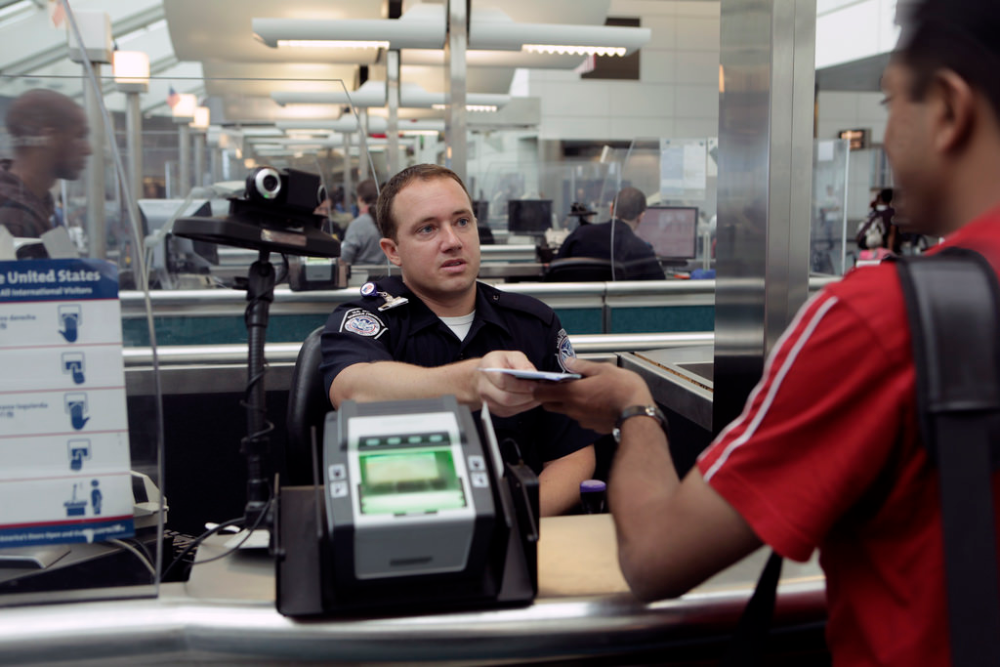
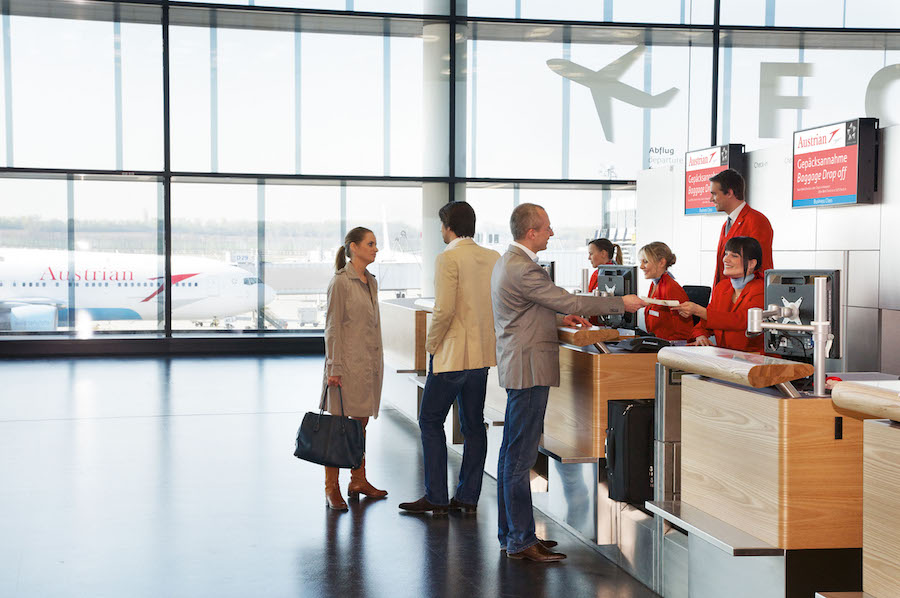
.jpg)



